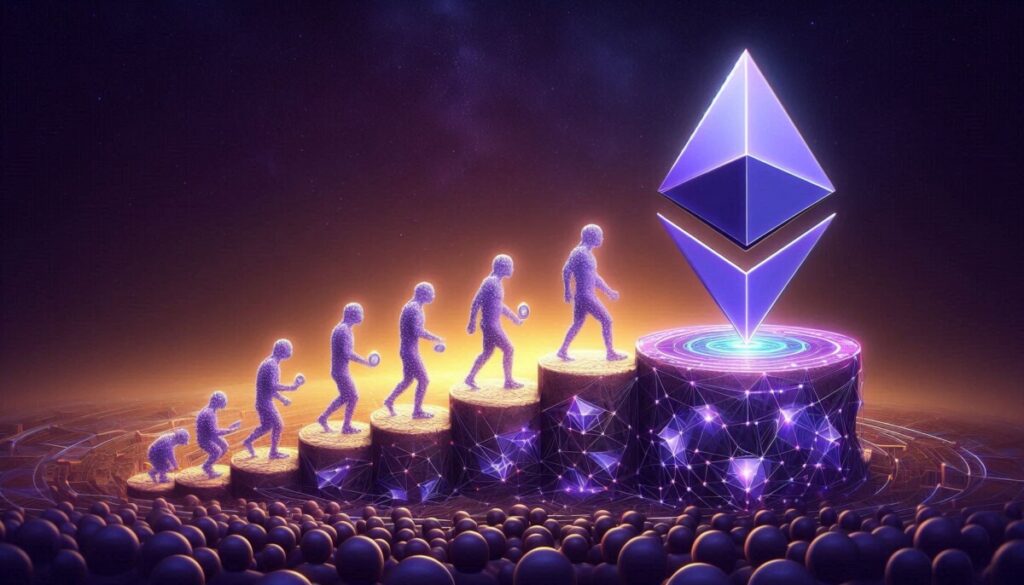Ethereum Is On A Tear...Fusaka Could Make It Even Better

Image created with AI
With an ETH rally in full swing, Ethereum's development team is toiling away on Fusaka – a network reboot that will streamline the blockchain's execution engine for even higher throughput and flexibility.
What began as a basket of sometimes conflicting ideas has hardened into a clear package of improvements: a higher ceiling on gas fees, caps on the number of data blobs per transaction, and new ways to connect decentralized finance (DeFi) with traditional e-commerce.
It all adds up to a faster network with more efficient block space utilization, moving Ethereum ever-closer to seamless off-chain integration.
Incremental excellence
At the start of the year, Fusaka was a loose collection of ideas. EIPs were being written to address a gas limit increase, fix blob fees, and answer open questions about the size of smart contracts.
Rather than unleash a host of new features, the Ethereum foundation has opted for tweaks, but the cumulative package is substantial.
These are the biggest improvements:
More Transaction Capacity Per Block
Arguably, the biggest change in Fusaka is a new upper gas limit of 45 million units, delivering a potential lift to block transaction capacity.
Ethereum's gas limit puts a cap on how much computational effort any single transaction can consume. It's a critical network parameter, setting limits on how much compute a block can use when executing smart contracts or handling transactions.
Expressed in units of gas, the fee Ethereum levies for transaction processing, the new limit is a deliberate traffic management tool. It helps avoid bottlenecks by constraining the cumulative complexity of operations included in each block.
If the change goes through, it could raise Ethereum's network transaction capacity by ~11%, though developers flagged the need to monitor and benchmark block propagation across different latencies. While not explicitly part of Fusaka, in the June 19 call, the foundation said the change had been validated by all clients.
Parithosh Jayanthi, part of the Ethereum Foundation's DevOps team, said "Once the releases are complete, all clients seem happy with moving to a 45 million gas fee limit."
New Blob Limits
Ethereum developers are also looking at how blob data should be handled. While the addition of data blobs in last year's Dencun upgrade enabled cheaper off-chain data availability, it didn't cap how many blobs could be included in a single transaction.
Fusaka's EIP-7892 clarifies that issue, capping per-transaction blob usage to stop any single dApp or rollup from overusing the available ‘blobspace.'
Another rejig, called EIP-7918, places an upper limit on the total number of blobs per block and sets a minimum base fee, making synergistic changes that help keep network scalability and security in balance. Without a bottom limit, during low-activity periods, the blob fee can drop to around zero, meaning blockspace is utilized efficiently.
A New CLZ Opcode
Another below-the-radar optimization for Devnet-2 is EIP-7939, which adds a count leading zeros (CLZ) opcode to the Ethereum Virtual Machine (EVM), the runtime environment for smart contracts.
This very techy fix will help developers compute the number of consecutive zero bits at the beginning of a binary number more efficiently, something crucial to cryptography, data compression, and operations that manipulate data at the bit level.
The current EVM doesn't have a dedicated CLZ opcode, forcing developers to implement CLZ using multiple operations.
A related change under EIP-7951 would enable direct on-chain connections to mobile and enterprise platforms via standard Web2 security authentication. That would move Ethereum ever closer to seamless integration with the off-chain world.
Community reaction
Fusaka’s more focused scope has drawn some criticism from Ethereum stakeholders.
In a post on X that's had 84,000 views, Georgios Konstantopoulos, CTO at Paradigm, expressed frustration about delaying a fix to the longstanding "stack too deep" error and the 24 KB limit on the size of a smart contract's bytecode – two pain points cited frequently by EVM developers.
The post sparked a lengthy thread and at least one rebuttal from an anonymous Prysm developer, Potuz, who noted that another planned upgrade called EVM object format (EOF) aims to resolve these issues, though it's now slated for a post-Fusaka upgrade.
Delaying EOF seems to be down to objections from network stakeholders. Critics argue that the change as currently scoped is over-engineered and could add more complexity to the already fiddly smart contracts system.
In a post on the Ethereum Magicians community portal, developer Pascal Caversaccio worried that the EOF proposal could weigh the network down with "unnecessary changes," including two new semantics (which define how smart contracts are written and executed) while deleting and replacing more than a dozen opcodes.
He said the stack-too-deep, bytecode, and other issues could be addressed incrementally "in less invasive updates." EOF as it stands might also require a tooling upgrade, he added, risking the onset of new exploits due to an expanded attack surface.
Caversaccio's concerns were echoed in a poll on ETHPulse, which found that around 40 voters holding an estimated 17,750 ETH were also opposed to the upgrade. As of July 2, 2025, only eight holders voted in favor.
The take away
Despite some community pushback and a lack of headline features, Fusaka could mark a significant milestone in the Foundation's push for better network performance. The fork aims for precise optimizations without fanfare or technological disruption.
With May's Pectra upgrade done & dusted, Fusaka aims to build on it by strengthening efficiency and taking the network a step closer to integration with the Web2 world.
Added performance without unnecessary risk. Ethereum’s low-key flex is a careful progression toward the next phase of technical maturity.
Benzinga Disclaimer: This article is from an unpaid external contributor. It does not represent Benzinga’s reporting and has not been edited for content or accuracy.
Posted-In: contributors Expert IdeasCryptocurrency Opinion Trading Ideas General



